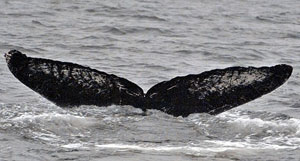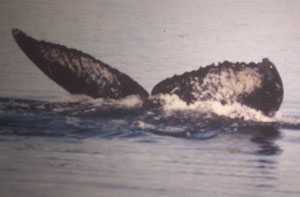 May 16, 2007
"With last year's sightings, this whale has the longest identification record, 35 years, of any humpback whale", said NOAA's Alaska Fisheries Science Center Director Doug DeMaster. "The record is a tribute to Charles Jurasz' pioneering work, which started in the mid-1960s, long before whale biologists considered using photo-identification as a research tool." The whale, most likely a male, is known as NMMLID 229. He was photographed near Maui by researchers from The Dolphin Institute in February 2006 and again by a team of researchers working under the scientific research permit of Sitka whale researcher Jan Straley in Southeast Alaska's Seymour Canal in December 2006. NMMLID 229 has been photographed more than 34 times over the years in Alaska and Hawaii by researchers from the Alaska Fisheries Science Center, the University of Hawaii, The Dolphin Institute, the Hawaii Whale Research Foundation, the Center for Whale Studies, the Center for Coastal Studies and others. Several other whales first identified by Charles Jurasz have similar sighting histories, though NMMLID 229 currently holds a slim lead for the longest identification period in the NOAA database. Chris Gabriele, whale biologist at Glacier Bay National Park and Preserve, confirmed that at least nine other Jurasz whales, first photographed in the early-to-mid 1970s, were seen in Glacier Bay as recently as last summer and are expected to be sighted again this season. "In the years since Charles Jurasz and a few other early pioneers started using photographs to identify individual whales, it's become commonly accepted for researchers to use photographs for individual whale identification," said DeMaster. "We're wondering if other people have any early whale photos they would be willing to share with the researchers at the Alaska Fisheries Science Center," DeMaster added. "What's needed is a copy of the whale photograph, the date and place. It's possible that we would then be able to match the photo with others in our database." "The Jurasz collection has proven invaluable to our understanding of humpback whale presence and behaviors in Southeast Alaska," said biologist Sally Mizroch, who developed and manages NOAA's whale-matching database in Seattle. "We would love to examine more old whale photos taken in the North Pacific." The Alaska Fisheries Science Center humpback whale database has over 30,000 photographs taken from throughout the North Pacific, sent in by researchers working in Japan, Mexico and the US west coast as well as Alaska and Hawaii. Aside from a few photos taken by retired Alaska Fisheries Research Center researcher Dale Rice in Mexico in 1966, Jurasz' photos are the earliest humpback photos in the collection. Charles Jurasz began observing humpback whales in Southeast Alaska in 1966. Within a couple years he, his wife Virginia and children Susan and Peter were devoting a large portion of their lives to the observation, study and protection of humpback whales in Southeast Alaska, according to now-grown daughter Susan Jurasz, who lives in Oregon. The family spent two decades in Southeast Alaska, working each summer to identify humpback whales as individuals with distinct home ranges. Their early work confirmed that each animal can be identified from the unique pattern and markings on the ventral side of their tail flukes. Their pioneering work began during the commercial whaling era, when studies of whale demographics were based on data collected from whale carcasses. Jurasz' methods, which relied on observing the same whales over many years, allow researchers to estimate calving rates, juvenile survival, and adult survival rates using simple observational, non-lethal methods. In 1998 the Jurasz family sent their photo collection to the Alaska Fisheries Science Center in Seattle so it could be integrated into NOAA's whale matching database. Charles Jurasz now lives in the Yukon and leads the Windfall International School of Environs, studying Fannin sheep, grizzly bears and wood boring insects in the Faro, Yukon area. Anyone with whale photos to contribute to the database can contact Sally Mizroch at 206-526-4030 or sally.mizroch@noaa.gov
Source of News:
Publish A Letter on SitNews Read Letters/Opinions
|
||

